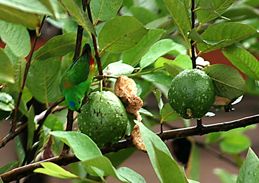Lam Chun See had a rare visitor in August 2007 when a pair of Blue-crowned Hanging Parrots (Loriculus galgulus) raided his guava tree (Psidium guajava). The birds were feasting on the fruits, giving Chun See a chance to record the visit – see his blog.
These are small, green parrots, about 12 cm long and rather rare in Singapore. The name comes from the prominent blue crown patch in the male, who also has a red throat-patch. According to Wells (2007), the bird rests and sleeps hanging upside down, with both feet tightly clutching the support. When it wants to defecate in such a position, it transfers support to one foot, flexes its body at an angle, raises its tail and shoot.
According to Chun See, “I noticed something interesting about the way it eats the guava. It takes a bite, bends down its head and ‘chews’ for a few second and then spits out what I think are the seeds. I thought birds always swallow the seeds and then excrete them; and thus help to propagate the plant?”
The female bird visited together with a juvenile, recognised by its yellowish bill (adults have black bills) (top).
The juvenile apparently was inexperienced and took a typical “begging” posture with lowered wings that shakes somewhat. It made begging cries all the time, asking to be fed. The female appeared to be ignoring it and continued feeding herself. This no doubt was to encourage the juvenile to learn how to feed itself.
A male, with a distinct blue patch on the crown, visited on another day by himself (left).
Lam Chun See
Singapore
September 2007
References:
1. Forshaw, J. M. (2006). Parrots of the world: An identification guide. Princeton & Oxford: Princeton University Press.
2. Wells, D.R. (2007). The birds of the Thai-Malay Peninsular. Vol. II, Passerines. Christopher Helm, London.











3 Responses
I believe that Blue-crowned Hanging Parrots have an underdeveloped gizzard which makes digesting most seeds very difficult.
Though the hanging parakeets are considered to be more closely related to the African lovebirds than the Asian lorikeets, from what is described, the behaviour resembles that of the lorikeets.
I have been keeping and breeding lorikeets of various species for about 50 years. Most that I have come across eat fruits in the manner described in the above post.
They are messy feeders, chewing fruits to extract the juices, then leaving the skins, seeds and sucked-out pulp scattered all over the place. No, the seeds do not pass through the intestinal tract.
I have no knowledge of the level of development of the gizzards of hanging parakeets, but not all lories have under-developed gizzards, though all eat fruits in this messy manner.
Lories of the Charmosyna genus (Stella’s, Josephine’s, Red-flanked, etc will perish very quickly on any hard diet. I have never known them to take seeds or formulated dry pellets, even though these are always available in my aviaries.
However, those of the genera Lorius, Eos, Trichoglossis and Chalcopsitta can survive on a seed diet for months or even years in the hands of ignorant owners. But such birds will typically be in poor condition and will do far better on diets with a high proportion of soft foods (fruit and nectar substitutes). Even then, if seed is available, lories of these genera willingly eat substantial amounts.
Some members of the parrot family, especially lories are also highly insectivorous and will pursue, capture and consume worms and insects with gusto.